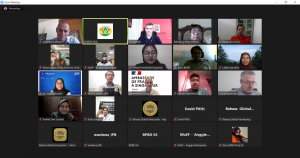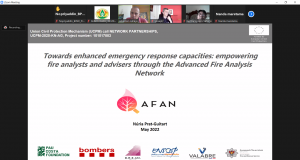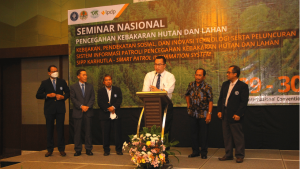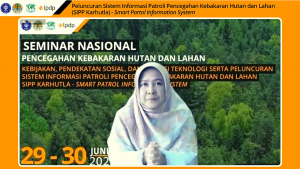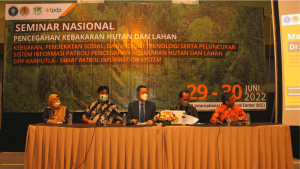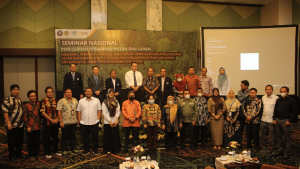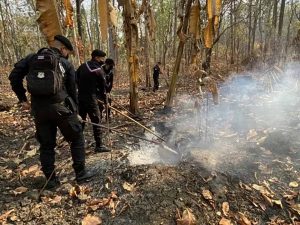Sustainable forests for combating climate change
Reporter: Prisca T V, Mecca Yumna | Editor: Sri Haryati
21 March 2022
Jakarta (ANTARA) – Indonesia is ready to embark on a new chapter of life, as the Nusantara Capital City begins its development with the rehabilitation of forests in the area, as said by President Joko Widodo.
During a visit to the Mentawir Nursery, North Penajam Paser District, East Kalimantan, on March 14, 2022, the president said that the rehabilitation was meant to revitalize the forest area around the city to its original function as a tropical forest and not a homogeneous monoculture expanse of vegetation.
Efforts to rehabilitate forests in the new capital will be supported by construction of the Mentawir Nursery that will produce 15-20 million seedlings to be planted in critical lands.
The measure was taken to materialize the concept of a forest city for the new capital, wherein of the 256 thousand hectares of the IKN authority area, around 70 percent is in the form of natural cover and trees.
Not only the new capital city, but other forests in Indonesia were also rehabilitated by the government, through the Environment and Forestry Ministry, in a bid to suppress the rate of deforestation in the country.
Rehabilitation efforts have been one of Indonesia’s focuses in recent years. The focus also extended to peat and mangrove areas.
Establishment of the Peatland Restoration Agency, which is now the Peat and Mangrove Restoration Agency, indicated the government’s commitment to restoring and rehabilitating degraded peat and mangrove areas.
The forestry and other land use (FOLU) sector is also in the spotlight when Indonesia targets a net carbon sink in the sector by 2030. It was expected that net zero emissions could be achieved in 2060 or earlier.
In the updated Nationally Determined Contribution (NDC) climate target document, Indonesia targets a 29-percent reduction in greenhouse gas emissions by 2030 alone. If the global community extended its support, it is expected to reach the 41-percent target of reduction.
Of these targets, FOLU has the largest reduction target of 17.2 percent through individual efforts and 24.1 percent with support from the global community.
The rest came from the energy sector (11 percent and 15.5 percent), waste (0.38 percent and 1.4 percent), agriculture (0.32 percent and 0.13 percent), and industry and product use or IPPU (0. 10 percent and 0.11 percent).
Indonesia’s commitment in the FOLU sector resulted in several achievements, one of which was the reduction of deforestation by 75 percent to 115,460 hectares during the 2019-2020 period.
This figure shows a decrease as compared to the deforestation of 462,460 hectares during the 2018-2019 period.
According to the ministry’s data, the gross deforestation rate during the 2019-2020 period reaches around 119,091 hectares, with reforestation covering an area of 3,631 hectares. Meanwhile, gross deforestation during the 2018-2018 period was recorded at 465,500 hectares and the reforestation area reached three thousand hectares.
The area burned due to forest fires has decreased in recent years. Based on SiPongi data from the Environment and Forestry Ministry, the area burned in 2021 reached 358,867 hectares, or up from 296,942 hectares in 2020.
However, this number shows a drastic decrease from the area burned in 2015 and 2019, which reached 2.6 million hectares and 1.6 million hectares, respectively.
In 2021, vegetative forest and land rehabilitation efforts were also conducted in an area of 203,386 hectares.
It comprises forest rehabilitation in an area of 46,752 hectares and mangrove rehabilitation in an area of 35,881 hectares.
As efforts to rehabilitate the land were made in an area of 67,138.73 hectares, so were the efforts to rehabilitate watersheds spanning an area of 11,709 hectares.
Sustainable forest
Environment and Forestry Minister Siti Nurbaya Bakar stated that Indonesia will continue to move to fulfill its commitments to control climate change without waiting for promises from developed countries. She delivered the statement on the occasion of the 2022 Forester Service Day.
To cement Indonesia’s commitment to achieving the FOLU Net Sink target by 2030, the ministry issued the Decree of the Environment and Forestry Ministry Number 168 of 2022 that contains the 2030 FOLU Net Sink Operational Plan.
The minister stated that after 2030, the FOLU sector was expected to be able to absorb greenhouse gases along with reducing emissions from energy transition activities as well as other sector exploration activities to achieve carbon neutral or net zero emissions by 2060.
Minister Bakar said that the program would apply the principles of sustainable development that include sustainable forest management as well as environmental governance and carbon management.
The main target remains on the efforts to reduce deforestation and forest degradation, she highlighted.
Although it is not easy, Indonesia will continue to employ the principles of sustainability as the basis for environmental development.
This sustainable foundation is also the theme of World Forest Day 2022, which is commemorated every March 21. This year’s theme is “Forests and Sustainable Production and Consumption.”
As quoted from the Food and Agriculture Organization (FAO) website of the United Nations, sustainable forest management is one of the keys to dealing with climate change.
Forests also play an important role in addressing poverty issues and meeting the targets of the Sustainable Development Goals.
Professor Herry Purnomo of the Faculty of Forestry at Bogor Agricultural University opined that public contribution was necessary to encourage sustainable forest management.
One effort that the public can make to contribute to the cause is to use certified forestry products.
The professor deemed it important since by buying certified products, the entrepreneur or forest manager would strive to meet such demands, thereby following the regulations of sustainable forest management.
Some of the certificates for sustainable forest production are the Timber Legality Verification System, or SVLK, issued by the government. SVLK aims to ensure that wood products and their raw materials are obtained from legal sources.
There are also several other certifications, such as global-scope ecolabels issued by the Forest Stewardship Council.
Some products with certifications that can be used by the community were furniture and paper, he pointed out.
To encourage the public to use forest products from sustainable sources, it is necessary to promote the behavior on a national or regional scale. People could start by using certified forestry products in government buildings.
He also called for consistency in the environmental recovery efforts that had been successfully brought up by Indonesia, using the momentum, such as the Indonesian G20 Presidency.
He expected that annually, efforts would be made consistently to decrease deforestation and increase reforestation.
Indonesia currently leads in terms of reducing deforestation, and the global community is mostly focused on various efforts being undertaken in the country.
By consistently pushing for a sustainable system and encouraging environmental recovery, Indonesia can lead by setting an example, backed up by the leadership of the G20 2022, he concluded.
COPYRIGHT © ANTARA 2022
Link: https://en.antaranews.com/news/220985/sustainable-forests-for-combating-climate-change
